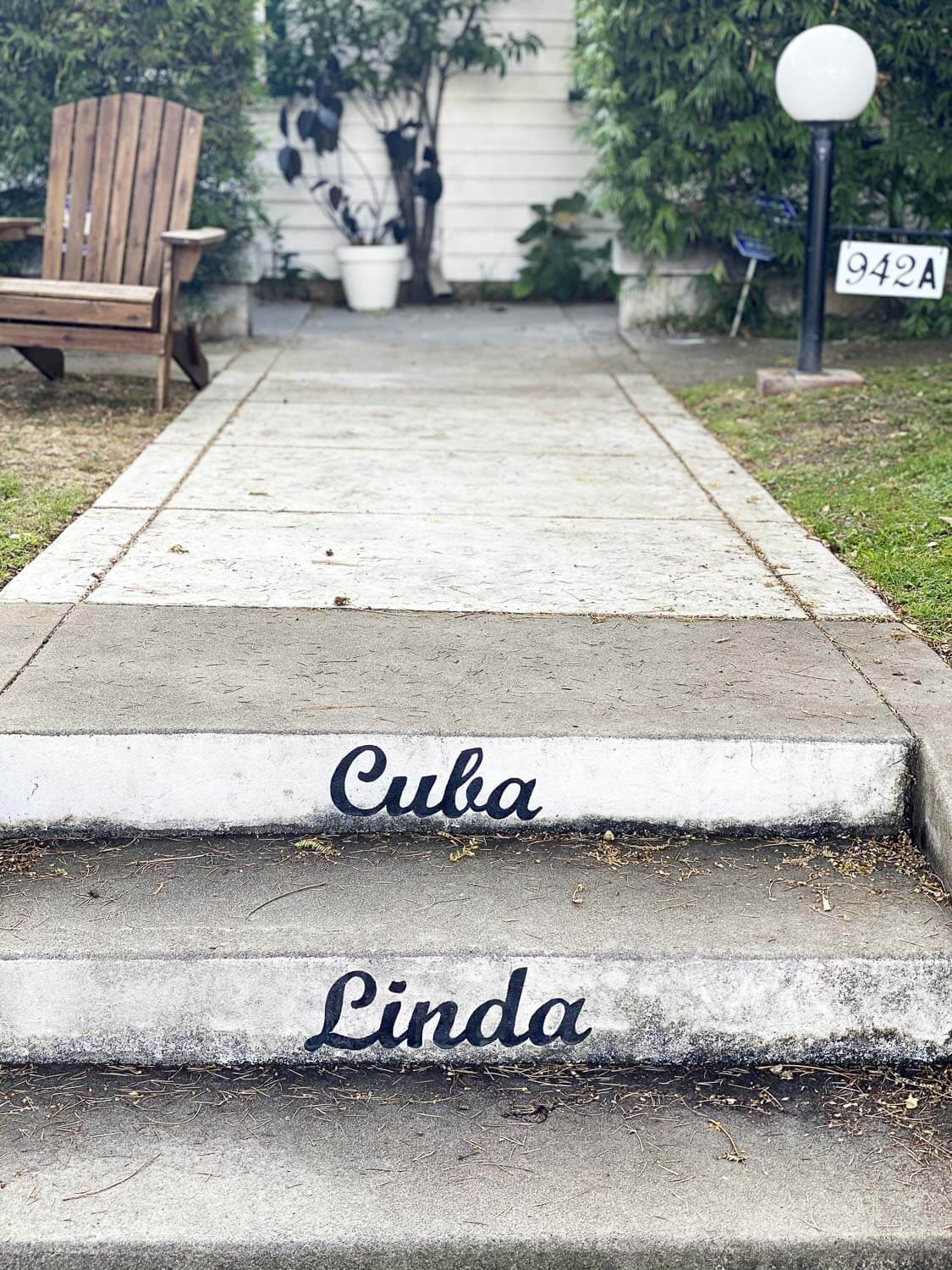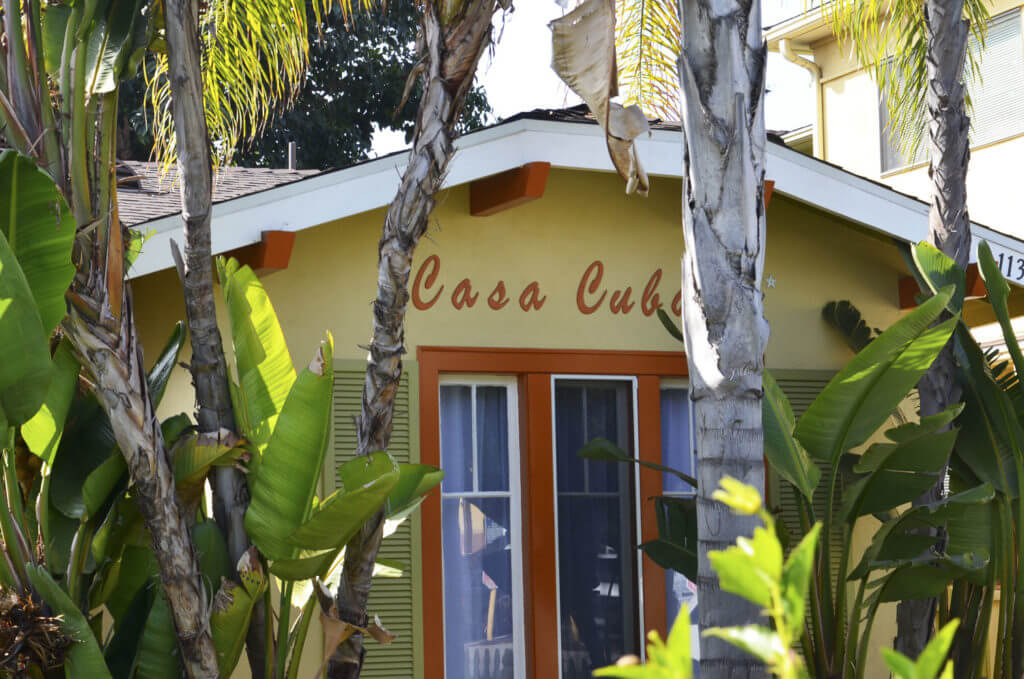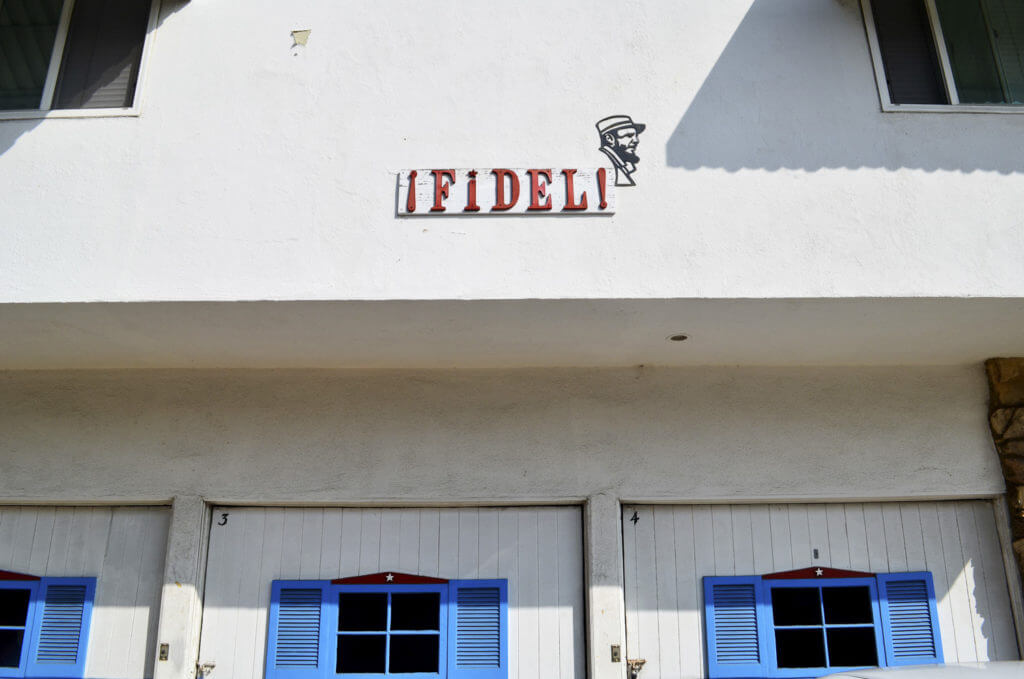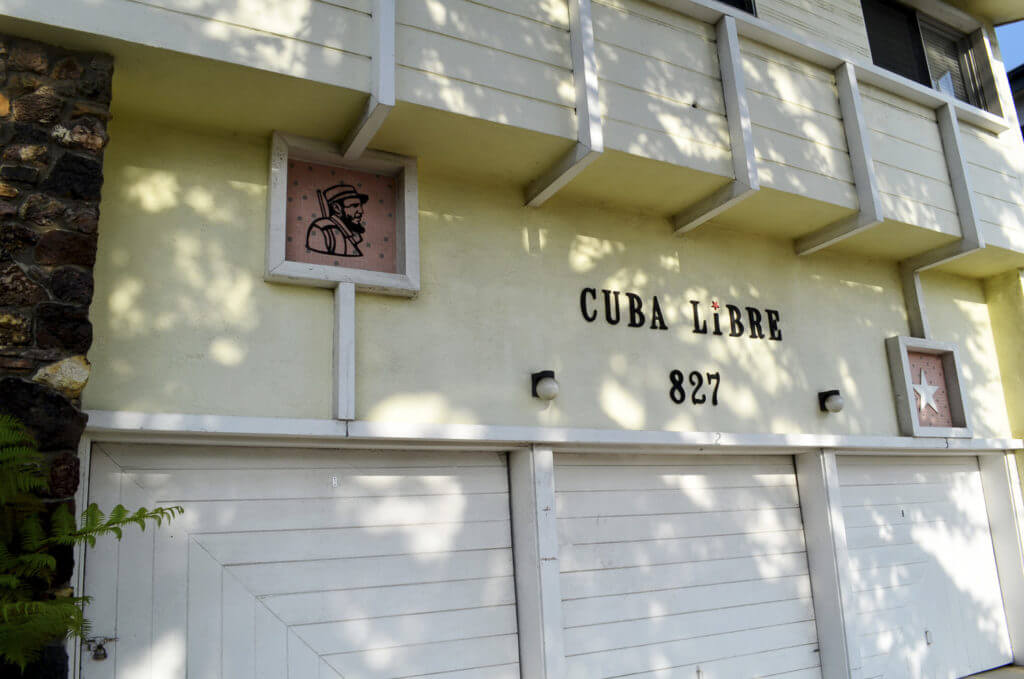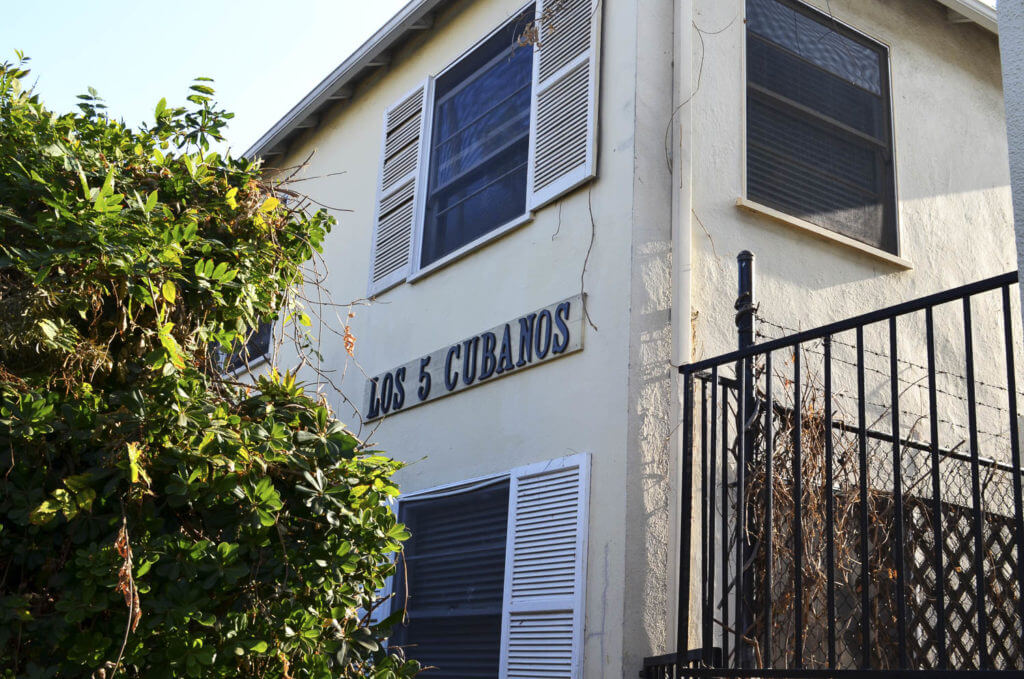We met the pro-Castro, communist property owner plastering the symbols of the Cuban revolution across “the People’s Republic of Santa Monica.”
Look closely at the stucco facades of these dingbat and bungalow court apartments and you’ll start to notice a patchwork of code words and images that tell the story of the Cuban revolution.
There’s the Cuba Libre building on Lincoln Boulevard, invoking the late-1900s battle cry of the Cuban Independence Movement. On Montana Avenue sits Sierra Maestra, named after the mountain range where Fidel Castro made his hideout as he led a guerrilla uprising in the late 1950s. And a Euclid Street bungalow, Villa Clara, stands for Santa Clara, the Cuban city where guerilla leader Ernesto “Che” Guevara led the decisive military victory that marked the end of the Batista regime. Down the street, Che rejoins his comrade-in-arms, Fidel, on a building’s exterior. Their gaze set upon the kind of neighborhood they dedicated their lives to trying to destroy.
The list of properties goes on. In total, 13 apartment buildings paint a tableau of the island’s most bloody, contentious and politically-charged signifiers of its role as a communist stalwart. It just so happens that an 86-year-old landlord owns them all, alone in championing the Castro regime within one of the nation’s top five most expensive cities to rent an apartment.
For decades, the rental properties have confronted passersby and residents with all the complexities and controversies of a revolution that, for better or worse, helped reshape the modern world. It’s exhausting for anyone who has personal ties to Cuba. I should know — I live next door to one. My father left Havana at age 15 for Guantanamo Bay, arriving nearly dead from the 500-mile trek he took to seek asylum at the American naval base there in 1968. Every time I step outside, I’m reminded of a country I’ve never been to, one from which my family fled and that I somehow still love. I had to meet Rachel Sene, the woman behind the Cuban agitprop apartments, partly out of curiosity and partly to learn about my father’s homeland.
Much like the Cuban state, Sene is a complicated, nuanced subject. A self-proclaimed communist, atheist and revolutionary, Sene may look like a grandma, but she has the intensity of a high school debater. Her staunch political views — and her conviction to voice them whenever and however necessary — have often landed her in the local news. Like the time she got in trouble for housing a homeless man in an unpermitted unit.
“I hate this city,” she says from the apartment she owns with her husband Jay Johnson in the North of Montana neighborhood of Santa Monica. “I had no fear to name these buildings.” And each name has a deliberate, almost literary, motif. Los Cinco Cubanos, named after the Cuban Five, goes on 5th Street. Euclid Street lies where 13th Street would have been, and Fidel’s birthday was Aug. 13, so his image goes to that building. And so on.
Sene often rotates the locations of her Cuban icons to fit a better narrative. At Sierra Maestra — the Montana Avenue building named after the Cuban mountain range — she plans to remove Che’s silhouette and move him down the street to Cuba Libre, where Fidel poses in a peaked fatigue cap, rifle slung over his shoulder.
Rachel Sene pays tribute to Cuba, the Cuban revolution and communism through her rental properties. Photos by Mariella Rudi.
“It fits there … It’s like it was calling. It was begging for it,” she says.
When a Breitbart editor took notice of her apartments, he wrote that if she and Johnson “actually lived in Cuba, their buildings would be expropriated by the state, with the bulk of their wealth siphoned into the bulging pockets of corrupt communist party officials.”
Sene wouldn’t have it any other way. She belongs to the older class of socially conservative Cubans currently at odds with one of the country’s newest economic reforms, known as cuentapropismo, or self-employed work, as well as the voters who supported a new constitution aimed at shaking up Cuba’s economic and political order.
“My cousins love the changes, but I’m such a militant communist that I don’t like that they can now sell their condos,” she says. “I liked it when the state owned it. They now have co-ops too, and I’m not happy about that.” In this evolving Cuba, a barber can own his barbershop, or a group of barbers can own a cooperative barbershop. Her family of “highly-educated” lawyers and university officials, who “love the changes,” aren’t affected, though.
Born to Jewish parents from Turkey, Sene spent her summers with her father’s side of the family on the island. Her parents, Emily and Isaac Sene, spent time in Cuba before emigrating to the U.S., first to New York, then Los Angeles. Though not extremists, the two would eventually become renowned in the world of Sephardic music.
Her mother once said that Sene was born a communist.
For Sene, Revolutionary Cuba represented how her life could have gone differently. She was kicked out of high school for getting pregnant at age 16.
“Not only could I not get an abortion, which I would have, but I couldn’t complete my education,” she says. With a nostalgic smile, she suggests that Fidel wouldn’t have let that happen to her. But because she had children during the Cuban Revolution, she couldn’t be alongside her heroes. Instead, she married the father of her children, who was able to finish his education. They divorced when Sene refused to stop attending anti-Vietnam War demonstrations in the 1970s. She took up with Johnson thereafter.
If she was religious, Sene says, Fidel would be her God. People call her nuts. It’s no sweat off her back.
“I’m used to that,” she says. “I voice how I feel.”
When asked about the name of Camilo, the apartment complex I live next door to, she lights up. Camilo Cienfuegos was one of Fidel’s top guerilla commanders, a charismatic, cowboy-hat-wearing Cuban exile commemorated on the Cuban 20 peso bill.
“He’s my favorite,” she says. “Everybody knows that Fidel was a lawyer. Che was a doctor. What was Camilo? A tailor. And what was he doing at the time of the Revolution? He was washing dishes at a restaurant in San Francisco. So I love him because I don’t believe he finished high school. I didn’t finish high school. And I like working-class people. He’s my very favorite. I absolutely adore him.”
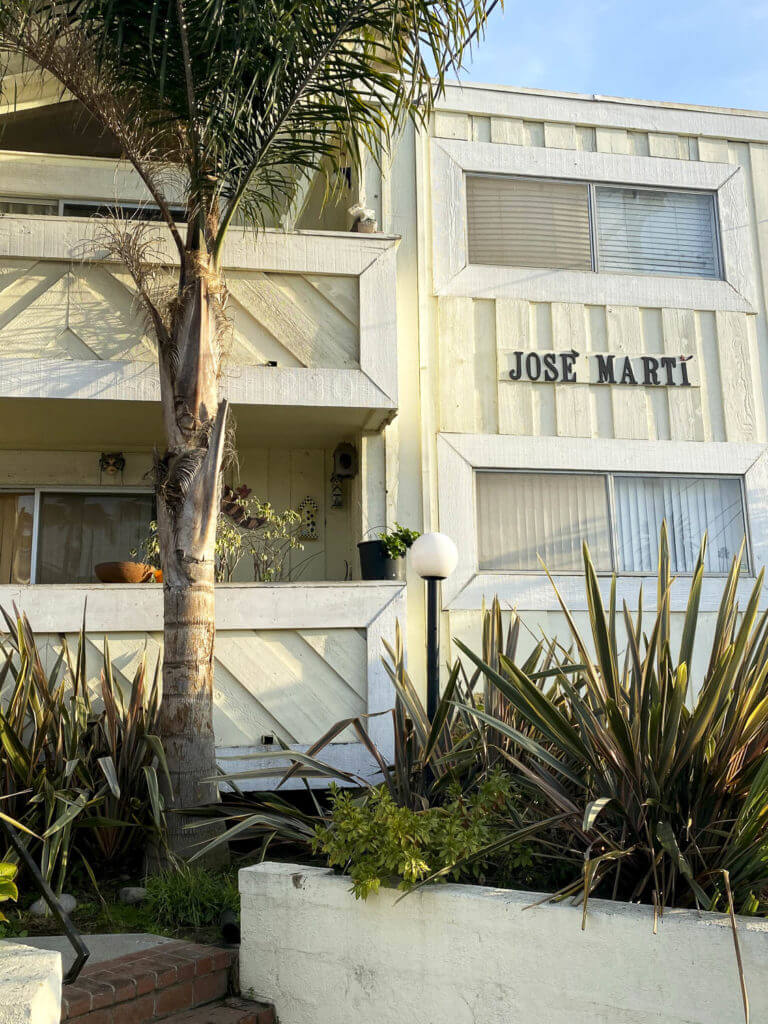
Camilo was Rachel’s first property in Santa Monica. How she came to own the land has nothing to do with Cuba. It was an accident. It all started in Palos Verdes, where Sene was living with Johnson in the 1980s.
“I did a personal favor to somebody, and I bought a tiny condo in Palos Verdes,” she says. “Some guy begged me to buy it, and he needed the money. It was going into foreclosure.” He needed $4,000 to stop the foreclosure. That’s all Rachel had saved — $2,000 for her daughter, Clara, and $2,000 for her son, Jeff. But she took a risk and bought the condo, which she rented out. When she moved to Santa Monica and didn’t want to deal with tenants in Palos Verdes anymore, she sold it — for $200,000.
She had never seen so much money in her life. “And then, Jay said, ‘Unless you buy something else in real estate, you gotta give $100,000 to the government,’” Sene says. So, she went out and bought the apartment building she named after her idol, Camilo Cienfuegos, 30 years after he helped create the first communist state in the western hemisphere. From there, rent money was steady and suddenly, she could buy another property. Then another. Each time she bought a place, it was for her children, a place for them to live and eventually own, the profits of their original $2,000 inheritance.
“And it all started from that guy, Leslie, who begged me to save him,” she says. And she never heard from Leslie again. “I didn’t buy as an investor. Everybody says, boy you’re really smart in real estate. Bullshit … Had I been business-minded, I would’ve bought businesses that pay off more.” And because of her politics, she only bought rent-controlled buildings.
Operating as Independent Property Management, LLC, she and her husband used to run the whole thing — from buying and escrow to management and legal proceedings — but today, her two children and their spouses oversee it.
Sene’s big plan, of course, was to retire in Cuba. She bought the condo. Everything was in place. Then in 2014, she was diagnosed with multiple myeloma, a blood cancer related to lymphoma and leukemia. She can only refill her cancer medicine every 21 days, so long-term travel is out. For now, Havana can wait.
The paradox of Cuba deepens when talking with Sene. It’s a country with free education and health care, praised for its international medical assistance program and progressive LGTBTQ+ programs, for its prowess in music and dance, in art and athletics. It’s also a country with a murky human rights record; a country that suppresses freedom of speech and assembly. It’s a place frozen in time yet full of potential. Where the basic state salary is $30 a month. Where dilapidated buildings stand on white-sand beaches. Where scarcity is met with resilience. And where exiles considered the water to be safer than the land. It’s easy to forget that the island and all its great dichotomies exist just 90 miles south.
There’s no Cuban community in Santa Monica, save for Sene and her small circle of friends and supporters. I doubt that the majority of her tenants, from ¡Fidel! to Cuba Linda, understand the political roots behind their apartment’s peculiar names. Or maybe they’re like me, split between the perceptions of communism and capitalism, of Cuba’s heroism and tyranny, all while trying to make rent on time in a city where we’ll probably never own property ourselves.

